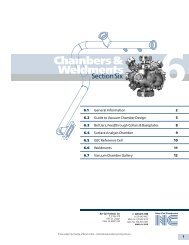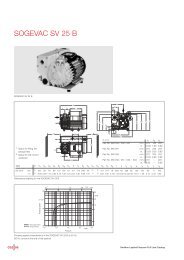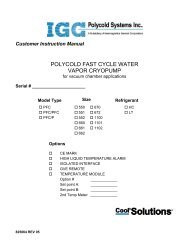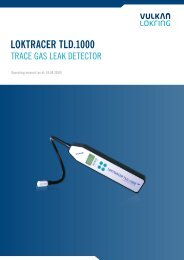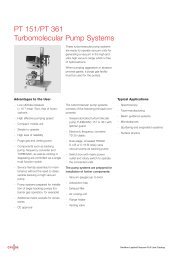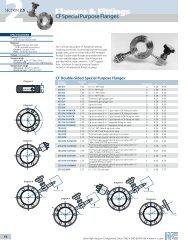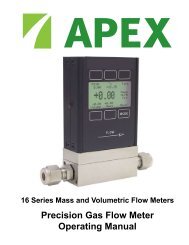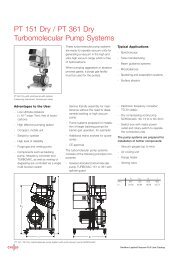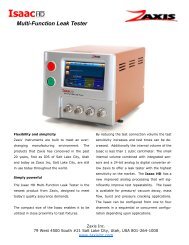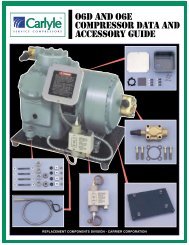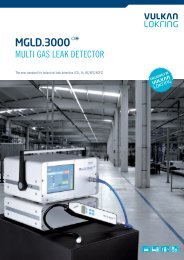INFICON CATALOG 2000-2001 - Schoonover, Inc.
INFICON CATALOG 2000-2001 - Schoonover, Inc.
INFICON CATALOG 2000-2001 - Schoonover, Inc.
You also want an ePaper? Increase the reach of your titles
YUMPU automatically turns print PDFs into web optimized ePapers that Google loves.
Vacuum Gauges<br />
Transmitter Technology<br />
Hot Cathode Ionization Vacuum Gauges<br />
In a hot cathode ionization gauge, the electrons emitted from the surface of<br />
a hot filament are attracted to a highly transparent grid made from very thin<br />
wire and at a positive electrical potential. With the grid so open, there is a<br />
very high probability that the electron will pass right through the grid and<br />
not strike a wire. If the grid is surrounded by a screen at a negative<br />
electrical potential, the electron will be repelled by this screen and be<br />
attracted back to the grid. This process can happen many times before the<br />
electron finally hits the grid and is lost. As a result, very long electron paths<br />
can be achieved in a small volume, increasing the probability of ionizing a<br />
gas molecule. The resulting ions are attracted directly to the collector.<br />
Most hot cathode sensors used are based on this Bayard-Alpert<br />
arrangement of electrodes. With this electrode arrangement it is possible<br />
to make measurements in the pressure range from 10 -10 to 10 -2 mbar (Torr).<br />
Other electrode arrangements permit access to a higher range of pressures<br />
from 10 -10 mbar (Torr) up to 10 -1 mbar (Torr). For measurement of pressures<br />
below 10 -10 mbar (Torr), extractor ionization sensors are employed. In<br />
extractor ionization gauges, ions are focused on a very thin and short ion<br />
detector. Due to the geometry of this system, interfering influences such<br />
as X-ray effects and ion desorption are almost completely eliminated.<br />
The extractor ionization gauge permits pressure measurements in the<br />
range from 10 -12 to 10 -4 mbar (Torr).<br />
<strong>INFICON</strong> improvements in electrode arrangements provide a wider<br />
measurement range combined with excellent repeatability. The Bayard-<br />
Alpert Pirani Combination Gauge further improves the measurement range<br />
in an easy to use package.<br />
Cold Cathode Ionization Vacuum Gauges (Penning)<br />
The cold cathode ionization gauge dispenses with the hot filament and uses<br />
a combination of electric and magnetic fields. If one applies a potential of<br />
a few kilovolts between a parallel plate capacitor in the presence of a gas<br />
pressure of a few mbar (Torr), a glow discharge will result. In the glow<br />
discharge, energetic free electrons interact with neutral molecules to<br />
produce ions and more free electrons. The ions are attracted to the negative<br />
electrode and when they strike it, secondary electrons are created, which<br />
are attracted to the positive electrode. The glow discharge continues as<br />
long as the number of electrons being created is equal to or greater than<br />
the number being removed at the positive electrode.<br />
Transmitter Technology<br />
Transmitters convert an analog input signal (pressure) measurement value<br />
into an analog normed electronic measurement signal, i.e. 0 Ð 10 V.<br />
This measurement signal is typically available as a linear or logarithmic<br />
output signal. The advantages of transmitters over conventional gauges<br />
with a separate signal processing device are:<br />
♦ Sensor and electronics in one compact package<br />
♦ Large cost savings<br />
♦ Direct connection to customer control units<br />
♦ A simple formula to convert the measurement signal into any desired<br />
pressure unit<br />
♦ Clear error messages can be transmitted because of the structured<br />
measurement signals<br />
♦ Digital interfaces (RS 232 C, Profibus, DeviceNetª) allow direct<br />
measurement readings in digital form<br />
♦ Integrated setpoint for direct process control based on<br />
pressure measurement<br />
♦ Measurement signals can be transmitted over greater distances<br />
The <strong>INFICON</strong> transmitter vacuum gauge line provides unparalleled<br />
performance for system manufacturers taking advantage of unique<br />
technologies combined with cost saving potential. The transmitter<br />
technology combines the sensor with the control and evaluation electronics<br />
in one compact package. Several output concepts like 0 Ð 10 V analog<br />
output, digital RS 232 C and fieldbus communications are available.<br />
<strong>INFICON</strong> transmitter technology reduces the costs for vacuum<br />
measurement and system integration to a minimum.<br />
The Penning gauge design employs a ring as the positive electrode<br />
(anode), which is centrally located between two electrically connected,<br />
negatively charged, parallel plates (cathodes). Electrons are attracted to the<br />
plane of the ring. Upon arrival, these electrons pass through the ring, and<br />
continue to oscillate between the two cathode plates. This configuration<br />
lowers the pressure at which a discharge can be sustained by increasing<br />
the electron path length. By introducing a magnetic field this electron path<br />
becomes a spiral, significantly increasing the path length. This further<br />
lowers the pressure at which the discharge can be maintained.<br />
<strong>INFICON</strong> design concepts permit safe and reliable operation of ÒPenningÓ<br />
sensors in the pressure range from 1á10 -9 mbar to 1á10 -2 mbar (Torr).<br />
B6.4



